The mystery of the ‘ghost’ railway engine
By Manjula Fernando
An unmanned lone engine had taken to the rails exactly a hundred
years ago.It was December 1913 to be exact. The engine had begun its
lone journey at that time from the Maligawatte rail yard.The time it
took to the rails was almost close to the time the shunting engine was
found moving this time around, a hundred years later- in December 2013.
Is it a spooky coincidence?
|
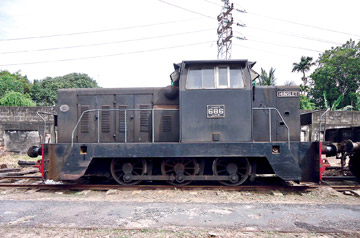
The runaway Shunting locomotive halted at the Ratmalana workshop
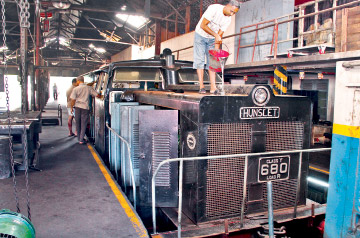
The runaway engine
Pix: Chinthaka Kumarasinghe and Corr Samad Ashraf |
The mystery of the ‘ghost railway engine’ that travelled nearly 15
kilometres without a driver, to be stopped at Ratmalana by three daring
technicians and a clerical worker from Dematagoda Hydraulic Locomotive
Shed, could well be a story of negligence. An inquiry has been initiated
and statements were being recorded when the Sunday Observer visited the
Main Control Office behind the Maradana Railway station on Friday. The
story which was the first of its kind in recent history roused much
interest among the public.
Our first stop was the Dematagoda Railway Yard where we met Motive
Power Engineer, Anura Samarakoon. He had rushed to the scene soon after
the runaway engine was sighted by one of the yard hands.
The ‘ghost engine’ that went on a nocturnal ride soon after midnight
on Wednesday, is still at the Ratmalana railway workshop where it will
remain pending the official inquiry. The Railway Department is currently
on a fact- finding mission to uncover themystery behind its lone
escapade.
The driver insists that on Wednesday he parked the shunting
locomotive (the Engine) inside the yard on Line 6 around 10 pm. He too
is an experienced worker at the Railway Department. When the alert came
from one of the yard-hands, who phoned the time keeper about the
unmanned engine moving out of the Shed, it was around 12.50am.
 |
 |
Motive Power
Engineer Anura
Samarakoon |
Deputy
Operating
Superintendent
A.D.G.Seneviratne |
This engine, manufactured in 1969 is one of the 28 shunting
locomotives brought down from the UK during GMR B.D.Rampala’s era. Made
by the reputed Hanslet Engine Company Ltd. of Leeds, England, it has a
Rolls Royce engine.
“All 28 engines are still in working conditon and except seven that
are in the Ratmalana Goods Shed for repairs, and the others were being
serviced,” Samarakoon said.
He said there were safety precautions every Shunting Engine Drivers
who works in the yard and the shed were required to follow and if that
was adhered to, a mishap of this nature could have been averted.
The time keeper alerted Samarakoon, who was asleep at home at the
time. Getting into action he communicated with his staff at the yard and
the superiors for advice as to what needs to be done.
The Control room was alerted and they kept track of the unmanned
engine. A presence of a train is indicated in the Control Panel of the
Main control room up to Katugoda on the coastal line.
“Our first instinct was how to stop the engine and avert a possible
disaster,” Samarakoon said.
Fortunately the runaway engine took off in the middle of the night,
after the last passenger train on the coastal line, from Maradana to
Aluthgama had left the station at 9.30pm It took Engineer Samarakoon
only eight minutes to reach the Dematagoda yard from his home in
Maharagama.
The time keeper Indika Rodrigo and foreman Nuwan Dharshana were
readying for any emergency.
|
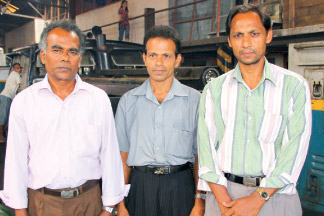 |
|
From U.Umange, Mahendra
Jayalal Perera and S.P.S.Premasiri |
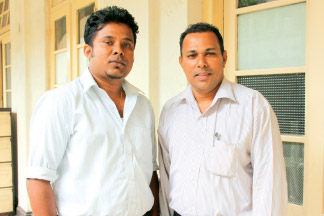 |
|
Indika Rodrigo and Nuwan
Dharshana |
“It was decided that we had to chase the runaway engine and try to
slow it down or derail it at some convenient point,” Samarakoon said.
Deputy Operating Superintendent, A.D.G.Senaviratne at the Control Room
was also consulted via telephone.Finally it was decided that the
derailment should be done in Ratmalana, which was the first point on the
open railway line that a diversion can be made.” Three technicians,
W.Umange, Mahendra Jayalal Perera, S.P.S.Premasiri and a clerical
staffer Indika Rodrigo volunteered to join in the chase and the yard
ambulance came in handy to clear the route. With sirens in full blow the
vehicle made its way towards Ratmalana in the middle of the night. “We
made our way to Ratmalana, at 2.00am before the engine got there.”
There were attempts on the way to block the engine with wooden logs
to curtail its speed, but proved futile. The engine was moving at a
steady but dangerous speed.
The four railway department workers began to run towards the on
coming engine from the Ratmalana station. About 300 metres to the
station, before the signal light the four of them boarded the moving
engine. “It was travelling at about 10 miles per hour at the time.”
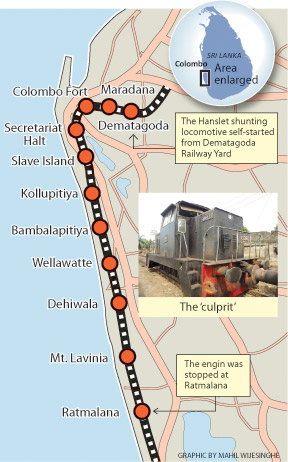 Umange who was the first to climb in is a about five feet. “I went
from the road side. The road was on a higher level than the railway
track and it was easy for me to hoist myself onto the engine.”The black
engine looked nerve- wracking in the thick of the night. But the four
workers wasted no time. Umange who was the first to climb in is a about five feet. “I went
from the road side. The road was on a higher level than the railway
track and it was easy for me to hoist myself onto the engine.”The black
engine looked nerve- wracking in the thick of the night. But the four
workers wasted no time.
Once inside the engine Umange shut off the engine and applied the
hand brakes. The engine stopped 30 metres from the station with no
damage to property or to the men involved.
“If this happened during daytime there would have been a disaster,”
Deputy Operating Superintendent Seneviratne at the Main Control Office
said. There would have been other trains on the busy coastal line and it
would have been tough for the Railway Department to secure the level
crossings and the tracks during the busy daytime. The engine passed
seven stations to reach Ratmalana.
A total of 54 passenger trains ply coastal line a day making 108
trips to and fro. This is in addition to four trips by freight trains.
The General Manager Railways has appointed a three- member committee
comprising Deputy Operating Superintendent Seneviratne, Deputy Chief
Mechanical Engineer M.J.D.Fernando and Deputy Chief Engineer Motive
Power K.K.Hewavitharana to find out who was responsible for the mishap
that may have ended in tragedy.
Believe it or not...
On December 5, 1913 a railway engine which was stationed at the
Maligawatte railway yard had started moving without a driver.
The engine had started around 1.45 am from
exactly the same spot where the shunting engine began its ghost ride
last week.
Only that it was at 12.50 am this time around.
According to our sister paper Dinamina which reported the incident in
its December 8 issue of 1913, it was suspected at the time that a night
cleaner may have started the engine by accident and he would have dashed
away out of fear when the engine began moving.
In this incident when the engine moved it had crashed on wayside
carriages but this time around there was no major mishap thanks to the
timely intervention of the Railway authorities. |

